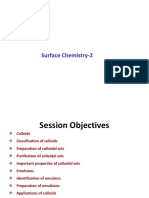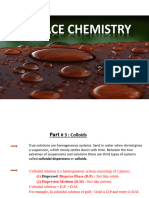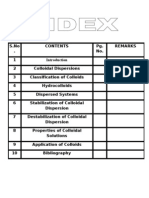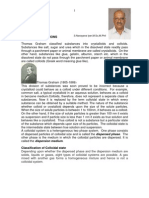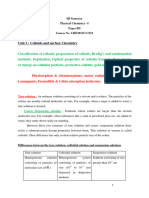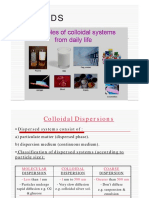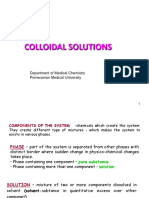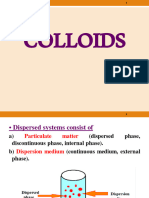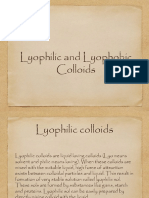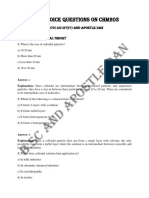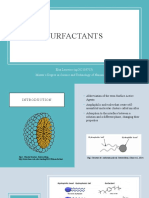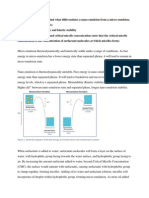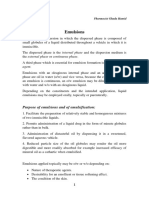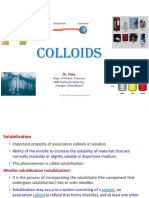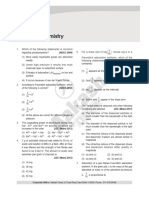Colloidal State
Uploaded by
Sarvesh GaonkarColloidal State
Uploaded by
Sarvesh GaonkarSession
Surface Chemistry-2
Session Objectives
Colloids
Classification of colloids
Preparation of colloidal sols
Purification of colloidal sols
Important properties of colloidal sols
Emulsions
Identification of emulsion
Preparation of emulsions
Applications of colloids
Colloids
Size of particles lies between that of true
solution and suspension, i.e. 10 Ao to 1000 Ao
Solute and solvent are replaced by dispersed
phase & dispersion medium
Sols( solid in liquid),gels(liquids in solids),
emulsions (liquid in liquid)
Property True solution Suspension Colloidal solution
Nature Homogeneous Heterogeneous Appears to be homogenous
but actually heterogeneous
Particle size < 10–9 Ao (1 nm) > 1000 Ao (100 nm) Between 10 Ao (1 nm) to
1000 Ao (100 nm)
Sedimentation Do not settle Settle on standing Do not settle
Diffusion Diffuse quickly Unable to diffuse Diffuse slowly
Visibility Particles invisible Particles visible by Particles scatter light and
naked eye or under can be observed under
microscope ultramicroscope
Filterability Pass easily through Unable to pass through Pass through filter paper
animal membrane animal membrane or but not through animal
and filter paper filter paper membrane
Appearance Clear and Opaque Translucent
transparent
Classification of colloids
Classification is based on following criteria
Physical state of dispersed phase and dispersion medium.
Nature of interaction between dispersed phase and dispersion medium.
Types of particles of the dispersed phase.
Classification based on
physical state of dispersed
phase and dispersion medium
Eight types of colloidal systems are possible.
Dispersed Dispersion Type of Example
phase medium colloid
Solid Solid Solid sol Some coloured glasses, and
gem stones
Solid Liquid Sol Paints, cell fluids
Solid Gas Aerosol Smoke, dust
Liquid Solid Gel Cheese butter, jellies
Liquid Liquid Emulsion Milk, hair cream
Liquid Gas Aerosol Fog, mist, cloud, insecticide
sprays
Gas Solid Solid sol Pumice stone, foam rubber
Gas Liquid Foam Froth, whipped cream, soap-
lather
Classification based on nature
of interaction
Lyophobic colloids (solvent hating colloids )
When metals and their sulphides simply mixed with
dispersion medium, they don’t form colloids.
• need stabilizing to preserve them.
• irreversible.
• For example, colloidal solutions of gold,silver, Fe(OH)3, As2S3, etc.
Lyophilic colloids ( solvent loving)
Directly formed by substances like gum, gelatine rubber etc.
on mixing with a suitable liquid(the dispersion medium).
• self-stabilizing
• reversible sols
• For example, gums, gelatin, starch, albumin in water.
Classification based on
type of particles of the
dispersed phase
Multimolecular colloids : Consists of
aggregates of a large number of atoms
or smaller molecules whose diameter is
less than 1 nm
Macromolecular colloids: In these colloids,
the molecules have sizes and dimensions
comparable to colloidal particles. For example,
proteins, starch, cellulose.
Associated colloids
At low concentrations, behave as normal, strong electrolytes
At higher concentrations exhibit colloidal state properties due
to the formation of aggregated particles (micelles)
The formation of micelles takes place only
above a particular temperature called
Kraft temperature (Tk) and above a
particular micelle concentration called
Critical Micelle Concentration
E.g Soaps and detergents
Multimolecular colloids Macromolecular colloids Associated colloids
Formed by aggregation of Formed by large Formed by aggregation of large
large number of atoms or sized molecules number of ions in concentrated
molecules with diameters solution
less than 1 nm
Lyophilic in nature Lyophobic in nature Both lyophilic and lyophobic in
nature
Molecular mass is High molecular mass High molecular mass
intermediate
Held by weak van der Held by stronger van der van der Waals’ forces increase
Waals’ forces Waals’ forces due to the with increase in concentration
long chains
Preparation of
Lyophobic sols
Condensation methods
Particles of atomic or molecular size are induced to form aggregates
Oxidation method
Sulphur colloids are prepared by oxidation of H2S by O2.
Reduction
Silver colloids are prepared by passing H2 through a saturated aqueous
solution of silver oxide at 65° C.
Hydrolysis
Dark brown Fe(OH)3 colloidal solution is prepared by adding FeCl3
into boiling water.
Double decomposition
Arsenious sulphide colloidal solution is prepared by passing of
H2S gas into a solution of As2O3.
Exchange of solvent
Colloidal solution of phosphorus is prepared by addition of alcohol
into a solution of phosphorous in excess water.
Preparation of Lyophobic
sols
Dispersion methods
Mechanical disintegration
By vigorous mechanical agitation.
Peptization : Process of passing of a precipitate into colloidal particles
on adding suitable electrolyte is known as peptisation
e.g. Fe(OH)3 solution is formed from FeCl3.
Electrol-disintegration (Bredig’s arc method)
Electrical disintegration of a colloidal solution, e.g. alternating
current passed through a gold solution.
Purification of colloids
Dialysis
In this process, the colloidal particles are separated from the
impurities (mainly electrolytes) by the diffusion through a porous
membrane such as parchment, collodion, etc.
Electrodialysis
This is a special type of dialysis process, which is accelerated by the
application of a potential difference across the membrane. So ions
migrate faster than the colloids .
Ultrafiltration
In this process the colloidal particles are separated by the process of
filtration, through a filter paper, which is impregnated with gelatin or
collodion followed by hardening in formaldehyde.
Properties of colloids
Optical properties: Tyndall effect
When a beam of light falls at right angles to the line of view
through a solution, the solution appears to be luminescent and
due to scattering of light the path becomes visible.
Quite strong in lyophobic colloids while in lyophilic colloids it is quite weak.
Properties of
colloids
Brownian movement: Zig- zag
movement of colloidal particles in
a colloidal sol
Properties of
colloids
Electrophoresis
Movement of colloidal particles under
influence of electric field
Properties of colloids
Electro-osmosis: molecules of dispersion medium are allowed to move
under influence of electric field
Coagulation or flocculation:Process which involves coming
together of colloidal particles so as to change into large sized
particles which ultimately settle as a precipitate or float on
surface.It is generally brought about by addition of electrolytes.
The minimum amount of an electrolyte that must be added to one litre
of a colloidal solution so as to bring about complete coagulation or
flocculation is called coagulation or flocculation value.Smaller is the
flocculation value of an electrolyte,greater is the coagulating or
precipitating power.
Properties of colloids
Hardy schulze law : Coagulating power of an
electrolyte increases rapidly with the increase in
the valency of cation or anion.
For negatively charged sol, the coagulating
power of electrolytes are
AlCl3 > BaCl2 > NaCl or Al3+ > Ba2+ > Na+
For positively charged, then the coagulating
power of electrolytes follow the following order:
PO 34 SO 24 Cl
Gold Number
Covering up of lyophobic particles by lyophilic
particles is known as its protective action and such
colloids are called protective colloids.
Gold number is defined as amount of protective sol
that will prevent the coagulation of 10 ml of a gold
solution on the addition of 1 ml of 10% NaCl solution.
Smaller the gold number,higher is protective power
Emulsion
A colloidal dispersion of one liquid in another
immiscible liquid is known as an emulsion,
e.g. milk, Na-soaps, vanishing cream, etc.
Types of emulsions
1. Oil in water, where oil is the dispersed phase and water
is the dispersion medium, e.g. milk.
2. Water in oil where water is the dispersed phase and oil
is the dispersed medium, e.g. butter, cream.
Cleaning Action of Soap
Soap contains a nonpolar carbon end that
dissolves in nonpolar fats and oils, and a
polar end that dissolves in water.
Dust and soap molecules form micelles
that dissolve in water and are
washed away.
Soap forms a precipitate with ions in hard
water (Ca2+, Mg2+, Fe3+)
Applications of colloids
1. Rubber plating
2. Sewage disposal
3. Smoke screen
4. Purification of water
5. Cleaning action of soap
6. In medicine
7. Formation of delta
8. Photography
9. Artificial rain
You might also like
- Chemical Engineering Univ. Sebelas Maret 2018No ratings yetChemical Engineering Univ. Sebelas Maret 201851 pages
- Colloidal Dispersion: Md. Zahidul Islam Zahid LecturerNo ratings yetColloidal Dispersion: Md. Zahidul Islam Zahid Lecturer48 pages
- 06 Introduction To Colloid Chemistry and Sol-Gel Process100% (1)06 Introduction To Colloid Chemistry and Sol-Gel Process26 pages
- Colloids - Class 12 Chemistry Investigatory Project Free PDF Download0% (1)Colloids - Class 12 Chemistry Investigatory Project Free PDF Download8 pages
- Colloids Colloidal SolutionNargis Maam - 104128No ratings yetColloids Colloidal SolutionNargis Maam - 10412874 pages
- Physical Chemistry =Unit 3 -ColloidsdocNo ratings yetPhysical Chemistry =Unit 3 -Colloidsdoc10 pages
- Milk, Butter, Cheese, Creams, Coloured Gems, Boot Polish, Rubber, Ink EtcNo ratings yetMilk, Butter, Cheese, Creams, Coloured Gems, Boot Polish, Rubber, Ink Etc18 pages
- Introduction To Colloid and Sol-Gel Chemistry: Chapter - 1No ratings yetIntroduction To Colloid and Sol-Gel Chemistry: Chapter - 125 pages
- Colloidaldisp1pptcompatibilitymode 120521101209 Phpapp02 PDFNo ratings yetColloidaldisp1pptcompatibilitymode 120521101209 Phpapp02 PDF46 pages
- Colloidal Solutions: Department of Medical Chemistry Pomeranian Medical UniversityNo ratings yetColloidal Solutions: Department of Medical Chemistry Pomeranian Medical University34 pages
- Colloidal Dispersion Systems: BY Dr. Musiba Baliruno Denis M.Pharm-Ind (Uon) 6 /02/2017No ratings yetColloidal Dispersion Systems: BY Dr. Musiba Baliruno Denis M.Pharm-Ind (Uon) 6 /02/201713 pages
- Oil and Water Won't Mix and Other Mixture Separation Techniques - Chemistry Book for Kids 8-10 | Children's Chemistry BooksFrom EverandOil and Water Won't Mix and Other Mixture Separation Techniques - Chemistry Book for Kids 8-10 | Children's Chemistry BooksNo ratings yet
- The Big Chemistry Book on Solutions - Chemistry for 4th Graders | Children's Chemistry BooksFrom EverandThe Big Chemistry Book on Solutions - Chemistry for 4th Graders | Children's Chemistry BooksNo ratings yet
- Pengeringan Etanol Dalam Kolom Unggun Tetap Dengan: Adsorbent Silica GelNo ratings yetPengeringan Etanol Dalam Kolom Unggun Tetap Dengan: Adsorbent Silica Gel4 pages
- Theories of Dispersion and Pharmaceutical Dispersion Emulsions AsadNo ratings yetTheories of Dispersion and Pharmaceutical Dispersion Emulsions Asad53 pages
- Factos Affecting The Properties of Nitrocellulose Emulsion A Comparative StudyNo ratings yetFactos Affecting The Properties of Nitrocellulose Emulsion A Comparative Study23 pages
- Created By: Heri Reksa S.Pd. Chemistry Teacher SMAN 1 BogorNo ratings yetCreated By: Heri Reksa S.Pd. Chemistry Teacher SMAN 1 Bogor45 pages
- The Effect of Particles On Surface Tension and Flotation Froth StabilityNo ratings yetThe Effect of Particles On Surface Tension and Flotation Froth Stability7 pages
- Figure 1: Schematic Diagram of The Free Energy of Microemulsion and Nanoemulsion SystemsNo ratings yetFigure 1: Schematic Diagram of The Free Energy of Microemulsion and Nanoemulsion Systems8 pages
- Micellar Solubilization: By:-Aakashsoni M.Pharma I Sem. Delhi Pharmaceutical Sciences and Research UniversityNo ratings yetMicellar Solubilization: By:-Aakashsoni M.Pharma I Sem. Delhi Pharmaceutical Sciences and Research University16 pages
- Interfacial Particles in Emulsions: Eric DickinsonNo ratings yetInterfacial Particles in Emulsions: Eric Dickinson52 pages
- Colloids: It Is A Mixture With Particle Size 1-1000nmNo ratings yetColloids: It Is A Mixture With Particle Size 1-1000nm1 page
- Coarse-Dispersion-Emulsion-Physical-Pharmaceutics-2 (Set 1)No ratings yetCoarse-Dispersion-Emulsion-Physical-Pharmaceutics-2 (Set 1)12 pages
- Low-Energy Emulsification - Applications in High Internal Phases EmulsionsNo ratings yetLow-Energy Emulsification - Applications in High Internal Phases Emulsions12 pages
- Colloidal Dispersion: Md. Zahidul Islam Zahid LecturerColloidal Dispersion: Md. Zahidul Islam Zahid Lecturer
- 06 Introduction To Colloid Chemistry and Sol-Gel Process06 Introduction To Colloid Chemistry and Sol-Gel Process
- Colloids - Class 12 Chemistry Investigatory Project Free PDF DownloadColloids - Class 12 Chemistry Investigatory Project Free PDF Download
- Milk, Butter, Cheese, Creams, Coloured Gems, Boot Polish, Rubber, Ink EtcMilk, Butter, Cheese, Creams, Coloured Gems, Boot Polish, Rubber, Ink Etc
- Introduction To Colloid and Sol-Gel Chemistry: Chapter - 1Introduction To Colloid and Sol-Gel Chemistry: Chapter - 1
- Colloidaldisp1pptcompatibilitymode 120521101209 Phpapp02 PDFColloidaldisp1pptcompatibilitymode 120521101209 Phpapp02 PDF
- Colloidal Solutions: Department of Medical Chemistry Pomeranian Medical UniversityColloidal Solutions: Department of Medical Chemistry Pomeranian Medical University
- Colloidal Dispersion Systems: BY Dr. Musiba Baliruno Denis M.Pharm-Ind (Uon) 6 /02/2017Colloidal Dispersion Systems: BY Dr. Musiba Baliruno Denis M.Pharm-Ind (Uon) 6 /02/2017
- Oil and Water Won't Mix and Other Mixture Separation Techniques - Chemistry Book for Kids 8-10 | Children's Chemistry BooksFrom EverandOil and Water Won't Mix and Other Mixture Separation Techniques - Chemistry Book for Kids 8-10 | Children's Chemistry Books
- The Big Chemistry Book on Solutions - Chemistry for 4th Graders | Children's Chemistry BooksFrom EverandThe Big Chemistry Book on Solutions - Chemistry for 4th Graders | Children's Chemistry Books
- Children Encyclopedia Chemistry: The World of KnowledgeFrom EverandChildren Encyclopedia Chemistry: The World of Knowledge
- Pengeringan Etanol Dalam Kolom Unggun Tetap Dengan: Adsorbent Silica GelPengeringan Etanol Dalam Kolom Unggun Tetap Dengan: Adsorbent Silica Gel
- Theories of Dispersion and Pharmaceutical Dispersion Emulsions AsadTheories of Dispersion and Pharmaceutical Dispersion Emulsions Asad
- Factos Affecting The Properties of Nitrocellulose Emulsion A Comparative StudyFactos Affecting The Properties of Nitrocellulose Emulsion A Comparative Study
- Created By: Heri Reksa S.Pd. Chemistry Teacher SMAN 1 BogorCreated By: Heri Reksa S.Pd. Chemistry Teacher SMAN 1 Bogor
- The Effect of Particles On Surface Tension and Flotation Froth StabilityThe Effect of Particles On Surface Tension and Flotation Froth Stability
- Figure 1: Schematic Diagram of The Free Energy of Microemulsion and Nanoemulsion SystemsFigure 1: Schematic Diagram of The Free Energy of Microemulsion and Nanoemulsion Systems
- Micellar Solubilization: By:-Aakashsoni M.Pharma I Sem. Delhi Pharmaceutical Sciences and Research UniversityMicellar Solubilization: By:-Aakashsoni M.Pharma I Sem. Delhi Pharmaceutical Sciences and Research University
- Interfacial Particles in Emulsions: Eric DickinsonInterfacial Particles in Emulsions: Eric Dickinson
- Colloids: It Is A Mixture With Particle Size 1-1000nmColloids: It Is A Mixture With Particle Size 1-1000nm
- Coarse-Dispersion-Emulsion-Physical-Pharmaceutics-2 (Set 1)Coarse-Dispersion-Emulsion-Physical-Pharmaceutics-2 (Set 1)
- Low-Energy Emulsification - Applications in High Internal Phases EmulsionsLow-Energy Emulsification - Applications in High Internal Phases Emulsions




